Wondering what is in-app advertising? In this blog, we have covered everything publishers should know about in-app advertising, and how to make the most out of it.
One thing we all can agree upon is that the usage of mobiles is widespread worldwide, and so is the usage of mobile apps. This makes in-app advertising a valuable platform for publishers and advertisers to strengthen their marketing efforts.
Read More: How are In-App Advertising Rates Calculated?
What is In-App Advertising?
As the name suggests, in-app advertising is simply a medium of advertising within apps. This approach allows advertisers to reach app users with targeted ads while providing app owners with a source of income from their monetized content.
In-app advertising is the ads you see while playing a mobile game, surfing through social media, or doing anything on a mobile app. It is an effective marketing technique that allows advertisers to reach the target audience based on the app’s demographics.
The best part about in-app advertising is that these ads are less distractive, non-disruptive, and best controlled and managed. These ads are placed to add to the user experience without ‘cutting’ their engagement on the app.
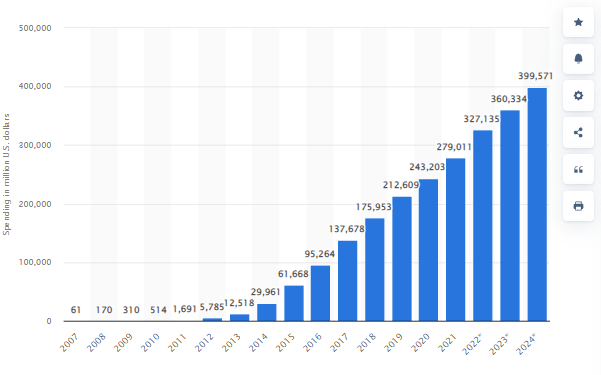
Importance of In-App Advertising for Marketers
In-app advertising has become a cornerstone of modern marketing strategies, holding immense importance for marketers across industries. And as we mentioned earlier, the usage of mobiles is very extensive, which is a lot more than desktops.

Developers looking to generate more revenue can tap into in-app advertising. Businesses that are looking forward to reaching a wider audience can also benefit a lot from in-app advertising because of the large number of users having multiple apps installed on their mobile. Not only that, but in-app advertising presents an opportunity for users to discover more relevant ads that promote new products and services based on their interests.
All in all, it offers opportunities for revenue generation, user engagement, audience targeting within apps, and a lot more benefits, which we have discussed below in the blog.
Who All Form the In-App Advertising Ecosystem?
The in-app advertising ecosystem is a complex system that involves various stakeholders and technologies to facilitate the delivery of advertisements within mobile applications. Here’s an overview of how the in-app advertising ecosystem generally works:
Publishers/Developers
These are the individuals or organizations that create and manage mobile applications. Developers integrate ad SDKs (Software Development Kits) into their apps to enable the display of ads.
Advertisers
Advertisers are businesses or individuals who want to promote their products or services. They create ad campaigns specifying the target audience, budget, and ad creatives.
Ad Networks
Ad networks act as intermediaries between advertisers and publishers. They aggregate ad inventory from multiple publishers and offer it to advertisers. They even optimize the ad selection and placement process, ensuring that right ads reach the right audience.
Ad Exchanges
Ad exchanges are platforms that facilitate the automated buying and selling of ad inventory in real time through a process known as real-time bidding (RTB). Publishers make their ad inventory available on ad exchanges, and advertisers bid for impressions in real time.
Demand-Side Platforms (DSPs)
DSPs are tools used by advertisers and agencies to manage their ad campaigns programmatically. They connect to ad exchanges to bid on ad impressions based on predefined criteria.
DSPs enable advertisers to target specific demographics, interests, or behaviours.
Supply-Side Platforms (SSPs)
SSPs are platforms that help publishers manage and optimize their ad inventory. They connect to ad exchanges to offer available impressions to advertisers, ensuring that publishers get the best possible price for their ad space.
Data Management Platforms (DMPs)
DMPs collect, analyze, and manage large sets of data to help advertisers and publishers make informed decisions. They enable better targeting by providing insights into user behaviour and preferences.
Ad Servers
Ad servers are responsible for delivering ads to users within the app. They store and manage ad creatives, targeting rules, and delivery schedules.
User
The end-users of the mobile applications who consume the content and view the ads.
And here’s how the ecosystem interacts with one another in this step-by-step process:
- A user opens an app with integrated ad SDK.
- The app sends ad requests to the ad network or ad exchange.
- Advertisers bid on the available ad impressions in real-time (if using RTB).
- The winning ad is selected based on various criteria, and the ad server delivers it to the user within the app.
This entire process happens in fractions of a second, creating a dynamic and efficient system for delivering targeted advertisements in mobile applications.
How Does In-app Advertising Work?
In-app advertising requires an ad network, app developers, and publishers to decide which portion of the app shall equip the ad and which ad format should work best.
Take a look at the following steps to learn more about how in-app advertising works:
Step 1. Marketers choose which audience to target and to whom the ads will show.
Step 2. The marketers and the app publishers/ developers decide upon the expenditure of the ad campaign, the format of the ads, and how they can maximize the ad revenue without disrupting the user experience.
Step 3. Once it’s all finalized, the ad network’s quality standards, protocols, and management system are checked. Upon getting a go, the ad network then queues up the ad.
Step 4. At the user’s end, the app triggers the network’s SDK (Software Development Kit) or API (Application Programming Interface), which tells the ad network that the user may be ready to see an ad.
Step 5. The ad network decides which ad should be relevant based on the SDK’s data. It enables maximizing the revenue for the app developer(s).
Step 6. However, the user may skip the ad or see the entire ad but not take the desired action. The user may also disengage from working within the app.
Step 7. Finally, it’s time for payout. The advertisers determine how the in-app advertising campaign has worked. The payout is made according to the performance of the campaign.
Benefits of In-app Advertising
In-app advertising offers a range of advantages for both advertisers and app developers.
Targeted Advertising
Targeted advertising can be conducted by leveraging user behaviour, demographics, and interests to reach specific audiences effectively.
Better User Experience
Users spend considerable time within mobile apps, providing advertisers ample opportunities to engage with them through well-placed and relevant ads. The use of rich media formats, such as videos and interactive banners, enhances user engagement, creating immersive experiences.
Robust Analytics
Additionally, in-app advertising platforms provide robust data analytics, offering advertisers detailed insights for campaign optimization.
Monetization
For app developers, the monetization potential is substantial, as they can generate revenue by incorporating in-app ads, especially in free apps.
Global Reach
In-app advertising also allows for global reach, breaking down geographical barriers and expanding the potential customer base.
Cost Effective
Moreover, the cost-effectiveness of programmatic advertising enables advertisers to optimize budgets by paying for specific criteria-based impressions or clicks.
Possible Drawbacks of In-app Advertising
Despite its numerous benefits, in-app advertising comes with its set of challenges.
Ad Fatigue: Users may become disengaged or irritated if exposed to the same ads repeatedly. Managing ad frequency is crucial to address this issue.
User Experience: These concerns arise when poorly designed or intrusive ads negatively impact the overall user experience, potentially leading to app abandonment.
Use of Ad-blocking Tools: The use of ad-blocking tools limits the visibility of ads to the user, reducing the effectiveness of in-app advertising.
Privacy Concerns: Changing user data collection practices may impact how advertisers target and track users within apps.
Technical Challenges: Challenges such as compatibility issues and varying device specifications, can pose hurdles to creating seamless ad experiences across a diverse range of devices.
Ad fraud: Fraud including fake clicks and impressions, remains a significant challenge in ad domain, emphasizing the importance of ensuring ad viewability and preventing fraudulent activities.
Competition: Advertisers must contend with numerous apps and rivals for users’ attention, requiring the creation of compelling and relevant content to capture and retain user interest.
Despite these challenges, the in-app advertising industry continues to thrive as advertisers and developers adapt to overcome obstacles and leverage the opportunities presented by targeted and engaging advertising experiences within mobile applications.
Read More: How are In-App Advertising Rates Calculated?
Mobile Websites vs Mobile Apps
Mobile websites and Mobile apps represent two distinct approaches for delivering content and services on mobile devices.
Mobile websites, accessible through web browsers, offer platform independence, making them available across various devices and operating systems. They are cost-effective in terms of development and maintenance, visible to search engines for better discoverability, and do not require installation. However, their offline functionality is limited.
On the other hand, mobile apps provide a superior performance and user experience, leveraging device features like the camera and GPS. They offer extensive offline functionality, contribute to brand loyalty through personalized experiences, and present monetization opportunities through in-app purchases and advertising. Apps can be distributed through app stores, enhancing visibility but introducing development complexities.
The choice between a mobile website and a mobile app depends on factors such as goals, functionalities, and target audience, with some businesses opting for both to cater to a broader user base and achieve diverse objectives.
| Feature | Mobile Websites | Mobile Apps |
| Accessibility | Accessible across platforms through web browsers. | Platform-specific downloaded and installed on devices |
| Development and Maintenance | Cost-effective, immediate visibility of changes. | Higher development complexity and cost, updates through app stores |
| Installation and Updates | No installation is required, and updates are immediate. | Requires installation, updates managed through app stores |
| Discoverability | Search engine visibility. | Distributed through app stores, a centralized platform for discovery |
| Offline Access | Limited offline functionality, enhanced with Progressive Web Apps (PWAs). | Extensive offline functionality, certain features accessible without the internet. |
| Performance and User Experience | Responsive but may have limitations. | Better performance, smoother user experience, and potential for enhanced graphics. |
| Access to Device Features | Limited integration with device features. | Leverages device features like camera, GPS, and push notifications. |
| Monetization Opportunities | Limited direct monetization options. | In-app purchases, subscriptions, and advertising offer diverse revenue streams. |
| Brand Loyalty | Lower compared to apps. | Apps contribute to increased brand visibility and loyalty. |
| Distribution | Accessible through web links. | Distributed through app stores (iOS App Store, Google Play). |
| Personalization | Limited customization. | Can offer a more personalized experience by storing user preferences locally. |
| Development Complexity | Lower complexity. | Higher complexity requires separate development for iOS and Android platforms. |
In-app Pricing Models
In-app pricing models refer to the strategies used by app developers to generate revenue from their applications. There are several ways in which developers can monetize their apps, each catering to different user preferences and business goals. Here are some common in-app pricing models:
Freemium
Description: Apps with a freemium model are free to download and use, but they offer premium features or content that users can purchase within the app.
Example: Many mobile games follow the freemium model, where users can make in-app purchases for virtual items, power-ups, or additional levels.
Paid Apps
Description: Users must pay a one-time fee to download and access the full functionality of the app. There are no additional in-app purchases.
Example: Productivity apps, premium versions of photography apps, or specialized tools often adopt a paid app model.
In-app Purchases (IAP)
Description: Users can make purchases within the app to access additional features, content, virtual goods, or premium subscriptions.
Example: Social media apps may offer in-app purchases for stickers, filters, or premium account features.
Subscription Model
Description: Users pay a recurring fee at regular intervals (monthly, annually) to access the app’s features or content.
Example: Streaming services like Netflix or music apps like Spotify often use subscription models.
Advertising (Ad Supported)
Description: The app is free to download and use, and revenue is generated through displaying ads to users.
Example: Many free games, news apps, and utility apps are ad-supported, displaying banner ads, interstitial ads, or video ads.
Pay-per-Download
Description: Users pay a one-time fee to download the app. There are no additional in-app purchases or subscriptions.
Example: Some premium apps, especially those with specialized or niche functionality, may adopt a pay-per-download model.
Affiliate Marketing
Description: Apps promote third-party products or services, and developers earn a commission for each user who makes a purchase through the app.
Example: Shopping or review apps that feature affiliate links to products on e-commerce platforms.
Licensing or White Labeling
Description: Developers offer a licensed version of their app to other businesses or individuals, allowing them to rebrand and use the app for their purposes.
Example: White-label dating apps or productivity tools that can be customized and used by other companies.
Crowdfunding
Description: Developers seek financial support from users or the community to fund the development or maintenance of the app.
Example: Some indie developers use platforms like Kickstarter or Patreon to gather funds for app development.
Sponsorship or Partnership
Description: Developers partner with brands or companies to integrate sponsored content or features within the app.
Example: A fitness app may partner with a sportswear brand to feature sponsored workout plans or challenges.
Choosing the right pricing model depends on the app’s purpose, target audience, and the value it provides to users. Often, a combination of models or a well-thought-out strategy is employed to maximize revenue and user satisfaction.
How to Calculate the In-app Advertising Cost?
In-app Advertising’s cost can be calculated in various ways. Here are the most popular ones:
CPM
Cost Per Mile means the cost per thousand impressions. Mille is the Latin for ‘thousand’. CPM refers to how much it costs to display an ad 1000 times on an app or website. CPM is one of the original and most common ways to for the ad.
It’s calculated as:
CPM= (Total cost * No. of impressions) / 1000
Here, the total cost means the total amount spent on the ad campaign. So, for example, if a publisher charges $5.00 CPM, the ad network has to pay $5 for 1000 impressions of the ad.
CPC
Cost Per Click means the average of the total cost by the number of clicks.
The idea behind this pricing model is that the advertiser will only pay if there’s an active interaction on the ad and the ad is clicked upon.
Its formula is:
CPC= Total Cost/ Number of Clicks
If two different ads, one costing $0.50 and the other costing $0.40, are clicked, the CPC will be:
$(0.50+0.40)/2
$0.90/2
$0.45
CPA
Click Per Acquisition refers to the cost of the ad determined by the completion of the actual purchase, download, installation, or free trial.
The advertiser, under this model, will pay when a purchase or download is made. It also means that the publisher takes all the risk of playing an ad until an acquisition is made.
The formula of CPA is:
CPA= Total Cost/ No. of Acquisitions
The app publishers and developers can discuss with the advertisers and decide which model best suits them.
Formats of In-App Advertising
Besides playable ads, there is a multitude of in-app ad formats.
1. Interstitial Video Ads
This type of in-app advertising is often seen in mobile game apps. Insteristial ads are full-screen banner ads that don’t end until the interval ends.
Pros:
- Highly Immersive
- Better impressions
- Better Conversions
Cons:
- Hampers with the user’s task
- It takes too much time to end
- It breaks the user’s engagement within the app
2. Rewarded Video Ads

Pros:
- Higher viewability
- Higher clicks
- High conversion rates
Cons:
- The attention span of the user has lowered, rendering these ads ineffective.
- There is no genuine interaction, as the users will only opt to watch this ad to gain a reward.
Read More: Rewarded Video Ads: 6 Essential Best Practices for 2023
3. Pre-Roll Ads
Remember the YouTube ads that automatically play within the video either at the beginning, in the middle or at the end of the video? Those ads are Instream Pre-Roll ads. These ads are usually 15, 20, 30, or even 60 seconds long. Some are skippable, while others may run for their determined duration.
Where are Instream Pre-Roll Ads Effective?
These ads effectively promote brand awareness and brand engagement, creating a purchase intent and conversion. The businesses are suggested to play pre-roll ads because the user shall be interested enough to sit through the ad to watch the original video. It ensures high viewability.
4. Native Ads
Native ads are non-intrusive and non-disruptive ads that don’t hamper the user experience. These adverts feel like the native content of the app and may appear as a welcome suggestion.
Picture the MakeMyTrip app, and upon clicking on the native content, you may come across an ad that just lies there without disrupting your engagement within the app. Native ads are highly targeted and reach the audience with pinpoint accuracy.
5. Banner Ads
They are small in size and may appear either at the top or the bottom of the screen within the app. It’s best to create brand awareness without hindering the user experience and huge reach.
Best In-app Advertising Networks in the Market
There are some great In-app Advertising partners on the market. Here’s a list of top 6:
AdPushup
AdPushup is a Premier Google Certified Publishing Partner (one of only six in the world). It provides publishers with 50+ premium demand partners including Google AdX, enabling a higher ad revenue.
They have no minimum traffic requirement, but they exclusively work with websites already generating $5,000/month in ad revenue. They also provide managed header bidding, comprehensive revenue reports, ad optimization, and efficient management functionalities, among other offerings.
Instagram / Facebook
These social media giants stand out as premier ad networks for reaching your target audience through robust and programmatic advertising campaigns, offering various ad formats to suit your needs.
Facebook, with its vast reach, achieved a revenue of $116.6 billion in 2022. It presents the potential to garner hundreds of thousands of impressions and thousands of conversions through a well-executed in-app marketing strategy.
Furthermore, both Instagram and Facebook platforms afford flexibility in audience targeting, timing, and advertising budget. Advertisers can tailor their campaigns based on demographic factors such as age, location, relationship status, gender, occupation, as well as interests and preferences.
AdMob
AdMob, a mobile platform owned by Google, serves as the mobile counterpart to Google AdSense. It proves to be a valuable ad network, particularly suitable for marketers embarking on their advertising journey, owing to its user-friendly interface and intuitive nature. Marketers can deploy various media types—video, images, text, or interactive content—to execute their programmatic ad campaigns effectively. Additionally, they have the flexibility to select from a range of ad formats, including interstitial, video, banner, native, and reward ads.
Smaato
Smaato is an excellent choice for mobile ad publishing, boasting a vast network of over 90,000 advertisers. The extensive advertiser base enhances the likelihood of publishers successfully selling their ad inventory. Additionally, publishers can leverage real-time bidding through SPX, the Smaato Publisher Platform, to maximize their ad revenue potential.
Unity
When it comes to targeting gamers, Unity is an ideal choice, tailor-made for showcasing video ad content to monetize mobile gaming apps. This ad network seamlessly integrates with both iOS and Android and offers support for all game engines, including Corona, Marmalade, and Adobe Air.
Moreover, it provides a convenient one-stop-shop solution for advertisers looking to engage gaming audiences. With Unity’s comprehensive network to incorporate in-app shopping functionality, gamers can search for and purchase products without exiting the game environment.
InMobi
InMobi is a prominent mobile ad network that caters to both mobile web and apps, enabling advertisers to execute diverse advertising campaigns through a unified platform. With support for both iOS and Android platforms, it facilitates ad campaigns based on cost-per-stall (CPI) and Cost-per-click (CPC) models.
The network ensures advertisers have a comprehensive set of tools to engage their target audience effectively, including a range of ad formats like rich media, interstitials, video, banners, and native options.
Best In-App Advertising Strategies to Practice
Implementing effective in-app advertising strategies is crucial for maximizing revenue and engaging users. Here are some best practices to consider:
- Set Goals: It is imperative to set goals and budget for your ad campaign before you begin.
- Targeted Advertising: Utilize user data and behavioural targeting to deliver personalized ads that are relevant to individual users’ interests and preferences. Targeted advertising increases the likelihood of user engagement and conversions.
- Optimize Ad Placement: Strategically place ads within the app to ensure visibility without compromising user experience. Consider factors such as screen real estate, user flow, and natural breaks in the app’s content to determine optimal ad placement.
- Frequency Capping: Implement frequency capping to control the number of ads displayed to users within a specific time frame. Limiting ad frequency prevents overexposure and minimizes the risk of ad fatigue, improving user satisfaction.
- A/B Testing: Conduct A/B testing to evaluate the performance of different ad formats, placements, and targeting strategies. Experiment with variations to identify the most effective approaches for maximizing ad revenue and user engagement.
- Reward-Based Ads: Offer users incentives, such as in-app rewards or premium content, in exchange for engaging with ads. Reward-based ads encourage user interaction while providing value, increasing ad engagement and retention.
- Opt-In Advertising: Implement opt-in advertising models where users voluntarily choose to view ads in exchange for benefits such as ad-free experiences, virtual currency, or exclusive content. Opt-in ads ensure a positive user experience while maintaining user privacy and control.
- Ad Mediation: Use ad mediation platforms to optimize ad revenue by integrating multiple ad networks and demand sources. Ad mediation dynamically selects the highest-paying ads from various networks, maximizing fill rates and eCPM.
- Contextual Targeting: Serve ads based on contextual relevance to the app’s content and user activity. Contextual targeting ensures that ads align with the user’s current context, enhancing relevance and improving engagement rates.
- Monitor Performance: Regularly monitor key performance metrics such as click-through rates, conversion rates, and revenue per user to assess the effectiveness of your in-app advertising strategies. Use analytics to identify trends, optimize campaigns, and make data-driven decisions for continuous improvement.
Final Thoughts
In-app advertising offers app owners a valuable opportunity to generate revenue by displaying ads within their mobile applications. By strategically implementing in-app advertising strategies, such as native ads, targeted advertising, and optimized ad placement, app owners can maximize revenue while maintaining a positive user experience.
Additionally, utilizing techniques like A/B testing, ad mediation, and reward-based ads can further enhance the effectiveness of in-app advertising efforts.
Overall, in-app advertising serves as a powerful monetization strategy for app developers, providing a sustainable source of income and driving app growth and success.
Before you leave, we’d like to do a little self-plug about ourselves too. Take a look at what AdPushup does and why we’re hand-picked by Google as a certified publishing partner.
AdPushup has helped more than 300 web publishers sustainably increase their ad CTRs, CPMs, and overall revenues without compromising on UX.
Take a look at how we delivered a 534% ad revenue uplift in 6 Months for CCNA7. If you want to learn how our technology can do the same for you, go ahead and request a free demo.
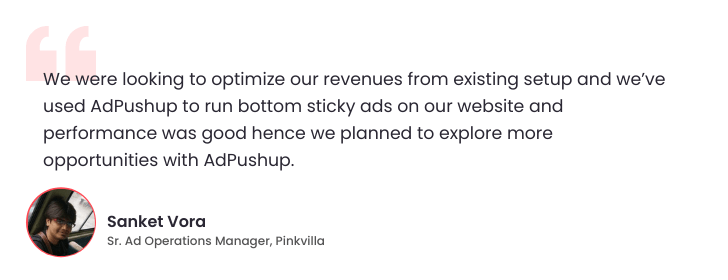
+
Frequently Asked Questions: In-App Advertising
In comparison with mobile websites, mobile apps are widely used. A user spends over 3 hours on average on mobile apps, making it a great platform for the in-app advertising networks to serve their ads there. In addition, mobile apps collect data that helps advertisers sort through the audience and target them as per their preferences.
You can get started with in-app advertising by choosing the right ad network, selecting the appropriate ad format, and choosing from the pricing model.
1. They target users with pinpoint accuracy based on demographics, mobile device IDs, operating systems, and wireless carriers.
2. No ad-blockers within the app make an ad reach its target audience.
3. Click-through rates show the efficiency and performance of an ad.
4. It becomes easy to get the targeted audience to reach your website or app and make the desired transaction.
5. Banner ads and video ads have higher clicks and viewability than in-app advertising. In contrast to this, browser CTR is only 0.01 per cent. And in-app advertising shows about 64 per cent of the viewability of a video ad.

Deepak has a keen eye for detail and a deep understanding of the ad tech landscape. Whether it’s through in-depth articles, thought-provoking insights, or compelling storytelling, he’s dedicated to helping people navigate the complex world of ad tech with the simplicity of his words.
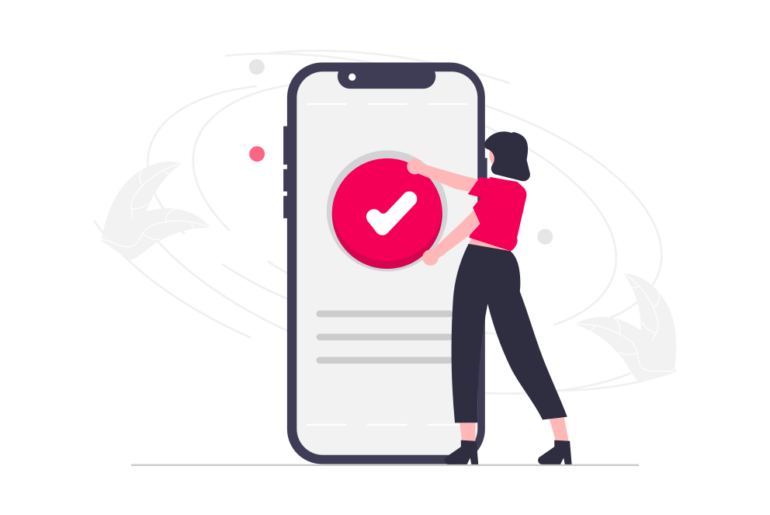
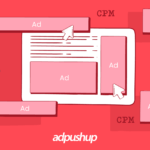
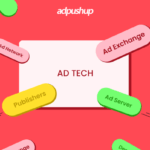
![Top 12 Ad Networks in India Every Publisher Should Know [2024 Edition] Indian Ad Networks](https://www.adpushup.com/blog/wp-content/uploads/2019/09/undraw_Note_list_re_r4u9-270x180.png)



